Vol 4 No. 3 TROPIC LIGHTNING NEWS January 20, 1969
Index
Manchus
Battle By Night, Lost AP Sweats It Out
By
1Lt. Mack Gooding
TAY
NINH
- A U.S. ambush patrol (AP) had just been alerted around midnight to the
presence of a large North Vietnamese Army force and was heading back to its
perimeter when NVA rocket and mortar fire opened a night-long battle that
stranded the AP in a deadly no man's land.
The patrol, sent out by the
4th Battalion, 9th Infantry, Manchus from their Mole City Patrol Base, 16 miles
southeast of Tay Ninh, was cut off 200 meters from friendly forces with enemy
forces all around. Sergeant Jose
Olea, Buffalo, N.Y., leader of the patrol, knew he couldn't get back to the
inviting bunkers of Mole City, the battalion's underground camp near the
Cambodian border.
"We were just starting to
move back in, crossing a rice paddy, when our point man saw some movement ahead
of us," Olea said. "I knew we couldn't stay in the paddy so we pulled back
to the thicket where we set up our ambush.
All we had was our fingernails, but we dug in as best we could."
Olea told his patrol to
'cool it,' hoping it could escape detection by the NVA regiment which was
charging the entrenched Tropic Lightning soldiers (with, as it turned out,
disastrous results for the enemy force: 106 killed).
But around 2 a.m., about 40 enemy troops headed toward the AP's
position.
"We were so far
out-numbered that we hoped they wouldn't see us, but one of the last ones
noticed something and started to bring his AK around in our direction," Olea
recalled. "Then we opened up on
them with grenades and pretty soon there were grenades falling all over the
place."
At one point, after the
patrol had run out of grenades, Olea threw a claymore mine, like a fisherman
casting, and detonated it on top of an NVA soldier who had lifted his head above
a nearby dike.
The Tropic Lightning patrol
was hard hit - three men killed and seven wounded.
"We couldn't get the wounded out, so we did what we could for them"
Olea said. "Until the morning
finally came, I thought I was the only one who hadn't been hit."
The dawn brought help from
the Manchus' main body to secure a landing zone for dust-offs for the wounded
and the end of a long night for Olea's patrol.
Captain Ramon T. Pulliam of
Chattanooga, Tenn., Olea's CO, praised him "for doing a fine job of keeping
his patrol under control at all times."
"Olea stayed calm, and
made sure his men didn't give away their position until they absolutely had
to," Pulliam said. "He saved a lot of lives."
| AERO-RIFLEMEN from Delta Troop, 3d Squadron, 4th Cavalry move out on a landing zone while the Tropic Lightning 2d Brigade soldiers were engaged in operations near An Duc. (PHOTO BY SP5 JERRELL JARVIS) | 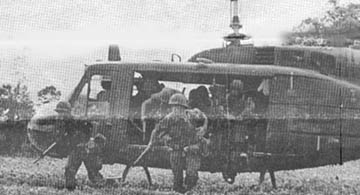 |
Regulars
Pounce On Dug-In NVA
CU
CHI -
While on an air-mobile operation ten miles northwest of Tay Ninh, B Company, 3d
Battalion, 22d Infantry battled a reinforced platoon-sized NVA element.
After a fierce fire fight, six of the enemy lay dead.
While establishing a
defensive perimeter, several men spotted two NVA soldiers walking along a trail
with their weapons held at sling arms.
The 3d platoon, in hot
pursuit, killed one NVA and wounded the other.
Following the blood trail with caution the platoon soon found itself
under heavy small arms, automatic weapons and RPG fire.
"We followed the blood
trail into a woodline where we discovered several freshly dug bunkers and
fighting positions. I arranged my
platoon into a line formation and we slowly probed forward throwing hand
grenades into the bunkers," said First Lieutenant Roland J. White of
Baltimore. "We knew that we were
going to have a heck of a time getting them out of their bunkers and that they
had no intentions of leaving them."
Maneuvering to join their
comrades, the Regulars poured out a devastating barrage of fire, allowing the 3d
Platoon to pull back to a location where the big guns of the 7th Battalion, 11th
Artillery, could be used to pound the enemy bunkers. Hovering gunships waited above for the Artillery to be lifted
so they could get their turn at clobbering the enemy.
Commander of Bravo Company,
Captain George D. Featherston of Houston, calmly said, "We inflicted a great
deal of damage upon them and were ready to move in further when we were forced
to return to our pickup zone because of the darkness."
BG
Black Arrives; New ADC, Support
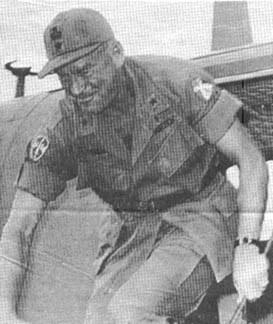 Brigadier General Edwin F.
Black recently assumed duties as assistant division commander for support at
division headquarters in Cu Chi. He
comes to the division from Korat, Thailand, where he commanded headquarters,
U.S. Army Support, Thailand (USARSUP-THAI).
Brigadier General Edwin F.
Black recently assumed duties as assistant division commander for support at
division headquarters in Cu Chi. He
comes to the division from Korat, Thailand, where he commanded headquarters,
U.S. Army Support, Thailand (USARSUP-THAI).
General Black was born in
New Orleans, Louisiana, 17 August, 1915. He
was graduated from the United States Military Academy, West Point, New York, in
1940 as a Second Lieutenant, Coast Artillery Corps.
From 1943 to the end of
WWII, he was a member of the Office of Strategic Services (OSS) (Special
Operations) in England, France and Germany.
He also served as OSS representative at the Supreme Headquarters, Allied
Expeditionary Force (SHAEF). After
the Normandy Invasion, he represented the OSS at the 12th U.S. Army Group Staff.
In July, 1945, he became commander of the OSS Detachment, Berlin and
Germany.
On his return to the United
States in 1946, Black was assigned to Joint Task Force One for the Atomic Tests
at Bikini. When the task force was
demobilized, he joined the Plans Division, Joint Research and Development
(R&D) Board, Office of the Secretary of Defense. In March, 1950, he transferred to Ft. Bragg, N.C., where he
took command of the 2d Battalion 505th Airborne Infantry Regiment, 82d Airborne
Division.
In June 1951, he joined the
Operations, Plans, Organization and Training Division, Headquarters European
Command, Heidelberg, Germany. In
October that same year, he was transferred to the Plans, Policy and Operations
Division, Supreme Headquarters, Allied Powers, Europe (SHAPE), Paris, France.
He returned to the United
States in October, 1952 and was assigned to the Office of the Secretary of
Defense as Military Assistant to the Deputy for Psychological Policy.
In February, 1953, he was named Assistant to the Assistant for National
Security Council Affairs, ISA, OSD, where he served until June 1954.
From December 1956 to March
1958 he was the commanding officer, 2d Battle Group, 19th Infantry, "Rock of
Chickamauga," 25th Division, U.S. Army, Hawaii. He then moved from the Tropic Lightning Division to the
Southeast Asia Plans and Policy Section, (Continued
on Back Page)
Page 2 TROPIC LIGHTNING NEWS January 20, 1969
Decorated
| BRONZE STAR MEDAL
(HEROISM) |
|
| COL
Lewis J. Ashley, HHC, 3d Bde LTC Andrew Anderson, HHC, 1st Bn, 5th Inf MAJ William E. Cates, HHC, 25th Inf MAJ Charles E. Bridwell, HHC, 2d Bn, 14th Inf CPT Lansing T. Hewitt, Co A, 2d Bn, 12th Inf CPT Dallas L. Cox, Co D, 1st Bn, 27th Inf CPT Richard H. Tessler, HHC, 2d Bn, 14th Inf CPT Franklin D. Daniels, Co B, 2d Bn, 14th Inf CPT Richard S. Humphrey, HHB, 1st Bn, 8th Arty CPT Gary J. Norton, HHC, 1st Bn, 5th Inf CPT Edward C. Schillo, HHC, 2d Bn, 27th Inf 1LT Dennis O. Flugard, Co B, 2d Bn, 12th Inf 1LT Harry D. Barnes, Co A, 2d Bn, 14th Inf 1LT Ronald J. Clary, Co, 1st Bn, 5th Inf 1LT Jay D. Zeiler, Co B, 1st Bn, 5th Inf 1TT Morgon J. Sincock, B Co, 4th Bn, 2d Inf 1LT Robert A. Nebiker, Co A, 2d Bn, 27th Inf 1LT James W. Booth, B Co, 65th Engr Bn 1LT Dennis M. Hicks, A Co, 1st Bn, 27th Inf 1LT Charles Jiron, D Co, 2d Bn, 27th Inf 1LT Stuart J. Greene, Co A, 1st Bn, 5th Inf 1LT Andrew D. Malloy, Co B, 1st Bn, 5th Inf 1LT Edwin Rogers, Co D, lst Bn, 27th Inf 2LT David Wrigley, Co D, 2d Bn, 14th Inf CSM Raymond C. Barrett, HHC, 1st Bn, 5th Inf PSG Kenneth H. Stroecscher, Co B, 1st Bn, 5th Inf SSG Bobby McVey, HHC, 2d Bn, 34th Armor SSG James L. McKenzie, Co C, 4th Bn, 23d Inf SGT Thomas Robbins, Co A, 1st Bn, 5th lnf SGT Wayne D. Finch, Co B, 4th Bn, 23d Inf SGT Phillip D. Williams, Co A, 1st Bn, 5th Inf |
SGT
Phillip E. Call, Co B, 4th Bn, 23d Inf SGT Dennis J. Rushing, Co C, 3d Bn, 22d Inf SGT Jerry Vandiver, Co D, 2d Bn, 27th Inf SGT Michael Weaver, Co A, 1st Bn, 5th Inf SGT Niel W. Fishback, Co B, 1st Bn, 5th Inf SGT Robert Clark, Co D, 3d Bn, 22d Inf SP4 Kenneth Cobb, Co D, 2d Bn, 27th Inf SP4 Arthur J. Park, Co B, 2d Bn, 14th Inf SP4 Wayne A. Rice, C Trp, 3d Sqdn, 4th Cov SP4 Daniel Gonzalez, Co A, 2d Bn, 14th Inf SP4 Daniel Rothstein, Co A, 2d Bn, 14th Inf SP4 John Yoder, Co A, 2d Bn, 14th Inf SP4 George Walker, Co C, 4th Bn, 23d Inf SP4 Bruce F. Cotta, Co D, 1st Bn, 5th Inf SP4 Michael M. St Auburn, C Trp, 3d Sqdn, 4th Cav SP4 Walter Sizemore, Co A, 1st Bn, 5th Inf SP4 Arthur L. Cook, 25th MP Co SP4 Michael T. Daly, 25th MP Co SP4 Raymond G. Morie, C Trp, 3d Sqdn, 4th Cav SP4 George W. Perry, Co D, 2d Bn, 14th Inf SP4 Joseph A. Deresta, HHC, 2d Bn, 12th Inf SP4 Michael Socia, HHC, 1st Bn, 5th Inf SP4 Gerald E. Kavarnos, Co C, 4th Bn, 23d Inf PFC Luther Mason, C Trp, 3d Sqdn, 4th Cav PFC John A. Busto, Jr, C Trp, 3d Sqdn, 4th Cav PFC Michael Kane, Co A, 1st Bn, 5th Inf PFC Phillip L. Hicks, A Trp, 3d Sqdn, 4th Cav PFC Harold A. Hunt, Co D, 2d Bn, 27th Inf PFC Benny R. Waller, Co A, 1st Bn, 5th Inf PFC Leonard L. Smith, Co B. 2d Bn, 12th Inf |
Rise
In Accidental Fatalities Stresses Safety's Importance
All we have to do is take a
look at the number and type of accidents that are occurring and one begins to
wonder what ever happened to common sense.
Since July 1, and through
December 31, 1968, Headquarters, 25th Division reports there were 15 injuries
and 3 military persons killed in addition to 32 Vietnamese injured or killed by
motor vehicle accidents.
Thirty-three were injured
and killed as a result of careless handling of small arms, 14 injured from
burns, 60 injured and seven killed from mishandled explosives, two fatalities
from drowning, 20 injured from falls and 38 other injuries resulting from cuts
and lacerations.
These unfavorable trends in
accidents must be reversed. The
U.S. soldiers are basically trained in the home, and in the service to be good
vehicle operators, to know their weapons and to use common sense.
Then with 201 injured and 28
killed during this period, what's the matter?
A lack of supervision,
individual responsibilities and just plain carelessness is evident.
When a person climbs to burn trash, or handles explosives, he can not
always depend on someone else to do his thinking for him.
There's no one to tell him, 'Do this', or 'Do that'.
It is up to the individual
to be observant, and quickly take any actions required to avoid an accident.
Common sense can save your
life.
Red
Cross Wire Service Means Help
One of the most valuable Red
Cross services available to the serviceman and his family, or in their behalf,
is that of communications and reporting.
Currently the American Red
Cross at the 25th Division is handling over 1,500 wire communications per month.
Communications service available to the serviceman and his dependents include
verification of family emergencies for leave purposes and leave extensions;
health and welfare reporting due to a serious breakdown in family
communications; transmittal of funds in circumstances where commercial
facilities are not adequate to meet
emergency needs, and others.
Services available to
commanders on behalf of the servicemen, and available only with the knowledge
and consent of the serviceman, include home condition reports; verification of
specific facts that were omitted from a serviceman's application for deferment
from overseas service, compassionate reassignment or hardship discharge; and
social histories.
Social histories may be
obtained under certain circumstances as an aid to rehabilitation of servicemen
who become prisoners, or for some military prisoners whose court-martial
sentence includes bad conduct or dishonorable discharge.
Background information can
also be obtained by Red Cross for use by hospital commanders when considered
essential to understanding a patient's condition and in planning treatment.
All reports obtained by the
Red Cross are confidential and can not be used as evidence in company punishment
or courts-martial.
For further information,
please contact the Field Office of the American Red Cross.
Helpful
Hints
Remember this when you get
back to CONUS: To be eligible for
travel at military standby rates, you must be in uniform and on active duty (or
be within seven days of separation or discharge) when purchasing tickets and
traveling. You must be traveling on
an official military leave or an authorized pass.
You must submit DD Form 1580. It
is available from your unit or personnel officer. Your time is too valuable to spend it all at the airport!
Tropic Lightning Tots
The Commanding General Welcomes
The Following Tropic Lightning Tots
To The 25th Infantry Division - As
Reported By The American Red Cross.
Born To:
| Dec
19 SP4 and Mrs. Calvin L. Casper, Co B, 2d Bn, 27th Inf., daughter Dec 20 CPT and Mrs. Richard S. Humphrey, Co B, 1st Bn, 8th Atry, daughter Dec 23 SP4 and Mrs. Lester R. Clark, Co. E, 725th Maint Bn, son |
Dec
23 SP4 and Mrs. Glenn H. Fey, Co B, 2d Bn, 14th Inf, daughter SGT and Mrs. Burnie L. Martin, Co B, 125th Sig Bn, son Dec 24 CPT and Mrs. Alfred J. Rembert, Svc Btry, 3d Bn, 13th Artillery, son Dec 27 SP4 and Mrs. Roy Lewandowski, Co E, 2d Bn, 27th Inf, son |
Tropic Lightning
Combat Honor Roll
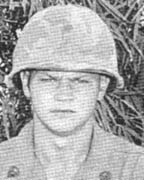 Added to the Tropic Lightning Combat Honor Roll this week is Specialist 4
Arthur R. O'Bryan of B Company, 25th Supply and Transportation Battalion.
Added to the Tropic Lightning Combat Honor Roll this week is Specialist 4
Arthur R. O'Bryan of B Company, 25th Supply and Transportation Battalion.
He distinguished himself by
heroic actions on December 17, 1968, while serving as a march unit commander for
the Dau Tieng resupply convoy with the battalion.
While proceeding to Dau
Tieng, the convoy came under a massive enemy attack, setting several vehicles on
fire and halting the column. Reacting
immediately, O'Bryan dismounted his vehicle and directed his column's
defensive positioning. He then
returned to his truck and secured an M-79 grenade launcher.
After he had secured his
weapon, he fearlessly moved through the enemy kill zone to the blazing vehicles,
where he observed three comrades who were pinned down by the enemy fire.
With complete disregard for
his own safety, O'Bryan continually exposed himself to the fierce Viet Cong
shelling as he placed a lethal barrage of fire on the aggressors' position,
destroying their emplacement.
His valorous actions were
responsible for the destruction of an enemy position and the prevention of
further damage and injury to the friendly convoy.
Specialist O'Bryan's
personal bravery, aggressiveness, and devotion to duty are in keeping with the
highest traditions of the military service and reflect great credit upon
himself, his unit, the 25th Infantry Division and the United States Army.
The TROPIC LIGHTNING NEWS is an authorized publication of the 25th Infantry Division. It is published weekly for all division units in the Republic of Vietnam by the Information Office, 25th Infantry Division, APO San Francisco 96225. Army News Features, Army Photo Features, Armed Forces Press Service and Armed Forces News Bureau material are used. Views and opinions expressed are not necessarily those of the Department of the Army. Printed in Tokyo, Japan, by Pacific Stars and Stripes.
MG Ellis W. Williamson . . . . Commanding General
MAJ Andrew J. Sullivan . . . Information Officer
2LT Don A. Eriksson . . . . . . Officer-in-Charge
SP4 Stephen Lochen . . . . . . Editor
SP4 Robert C. Imler . . . . . . . . Assistant Editor
SP4 Tom Quinn . . . . . . . . . . . Production Supervisor
Page 3 TROPIC LIGHTNING NEWS January 20, 1969
Three
Tropic Lightning Men Awarded DSCs For Valor
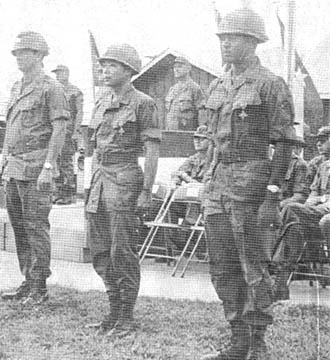 |
| Captain Jerry J.
Boyington, B Co., 25th Avn. Bn. Captain Boyington distinguished himself by exceptionally valorous actions on 5 August 1968 as commander of a smoke screening helicopter in support of combat assault operations near the town of Bau Trau. A flight of troop-carrying helicopters approaching a landing zone came under intense hostile fire from an estimated battalion of North Vietnamese forces, which included an anti-aircraft company. Captain Boyington fearlessly maneuvered his aircraft between the troop ships and the enemy fusillade to lay screening smoke for the unarmed aircraft. Disregarding his safety, he placed the smoke screen to within meters of the hostile positions, and by flying at point blank range, drew the deadly fire away from the troop-laden aircraft. He continued to protect the landing troops until the murderous barrage damaged his helicopter, forcing him to break contact. Captain Boyington's extraordinary heroism and devotion to duty were in keeping with the highest traditions of the military service and reflect great credit upon himself, his unit and the United States Army. |
2Lt. Vincent H. Okamoto, B Co., 2nd Bn., 27th Inf Second Lieutenant Okamoto distinguished himself by exceptionally valorous actions on 24 August 1968 while serving as a platoon leader with an infantry unit near Dau Tieng. A ground attack was launched against his battalion's night location by three reinforced North Vietnamese and Viet Cong companies. The initial assault destroyed a strategic section of the perimeter. Under heavy automatic weapons, small arms and rocket-propelled grenade fire, Lieutenant Okamoto moved five of his men to restore this vital position. Realizing the need for supporting fire, he ran to a partially destroyed armored personnel carrier and manned its machine gun. After the weapon malfunctioned, he dashed through the fusillade of enemy fire to a second and then a third carrier to place suppressing fire on the aggressors. Second Lieutenant Okamoto's extraordinary heroism and devotion to duty were in keeping with the highest traditions of the military service and reflect great credit upon himself, his unit and the United States Army. |
SP5 Lester W. Brown, Hq. Co., 2nd Bn, 27th Inf Specialist 5 Brown distinguished himself by exceptionally valorous actions on 27 August 1968 while serving as a medical aid man with an infantry unit. He was a member of an ambush patrol operating 500 meters beyond the main unit's defensive perimeter. The enemy launched an intense mortar and rocket attack on the small element, and followed it with a ground assault. Nineteen members of the thirty-man team became casualties. Specialist Brown moved through the heavy enemy fire and administered first aid to his wounded comrades until he had expended his medical supplies. He then crawled through a hail of bullets to the base camp where he gathered a desperately needed resupply of medical materials and organized a rescue team. Leading two armored personnel carriers to the stricken patrol's location, he placed the wounded on the vehicles and returned with them to the unit's position. He was directly responsible for saving the lives of fourteen men. Specialist 5 Brown's extraordinary heroism and devotion to duty were in keeping with the highest traditions of the military service and reflect great credit upon himself, his unit and the United States Army. |
Gen.
Abrams Awards DSCs
THE
THREE AWARDS
of the Distinguished Service Cross were presented at ceremonies held at the 25th
Infantry Division headquarters, Cu Chi. General
Creighton W. Abrams, commanding general, U.S. Military Assistance Command,
Vietnam, awarded the nation's second highest decoration for valor to the three
recipients as Major General Ellis W. Williamson, 25th Infantry Division
commanding general, looked on.
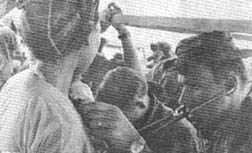 |
TAKE A DEEP BREATH - Captain Robert P. Doyle, battalion surgeon with the 4th Battalion (Mechanized), 23d Infantry, examines a Vietnamese woman during a tri-nation medical civic action program held at Suoi Da, two miles east of Nui Ba Den Mountain. Philippine civic action workers appear below. (PHOTO BY SP5 DONALD BROWN) |
1st
Bde Conducts A Tri-Nation Medcap
TAY
NINH
- A tri-nation MEDCAP (medical civic action program), sponsored by the 1st
Brigade's Civic Action Section, was held in the hamlet of Suoi Da, two miles
east of Nui Ba Den Mountain.
The program was conducted by
medics from the 4th Battalion, 23d Infantry, and medical teams from the
Vietnamese Health Ministry and Philippine Civic Action Group Vietnam.
The tri-nation MEDCAP was the first of its kind in the history of the 1st
Brigade.
During the historic MEDCAP,
members of the Vietnamese Health Ministry inoculated 600 persons against plague,
including all the children attending the Suoi Da Elementary School.
Sixty-two patients were
treated by doctors from the Tay Ninh Philippine Civic Action Group and 155
persons were treated by medics from the 4th of the 23d and the Philippine Group.
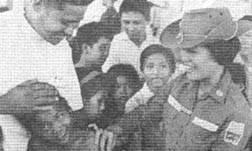 |
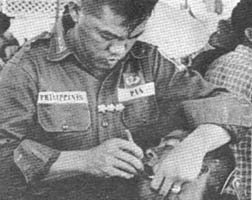 |
| PHILIPPINE CIVIC ACTION work is done by Captain Jaidi Silverio, of the Tay Ninh civic action group (above, left) as she inoculates a young Vietnamese schoolgirl against plague. (Above, right) Captain Ruperto Pia, Jr.examines a patient, one of 62 given dental treatment that day. (PHOTOS BY SP5 DONALD BROWN) |
Page 4-5 TROPIC LIGHTNING NEWS January 20, 1969
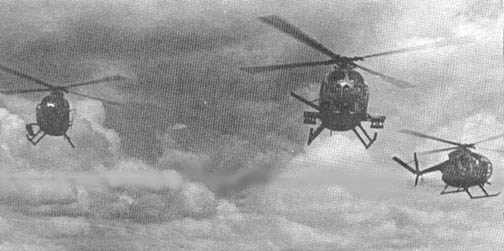 |
| THREE SHIPS pictured above, all Light Observation Helicopters, are capable of performing a half dozen missions and comprise the 2d Brigade aviation crew. The ships perform people sniff, 2.75 inch rocket, loud speaker psyops and minigun missions. They are also capable of command and control, resupply and passenger missions. The Tropic Lighting 2 Brigade fleet is the first in Vietnam with such a wide range of capabilities. |
Imagination
Creates A Big Success
When a need and a feasible
idea come together, things really start to happen.
It's not news to say the
Army has many needs, but it is news to say many of those needs are being solved
in Vietnam by men of imagination.
Several recent projects in
the Tropic Lightning's 2d Brigade have begun to come to light which indicate
significant advances for the fighting man.
In particular, these
projects are in three specific areas; communications, aviation, and
psychological operations (PSYOPS); and in one way or another all three seem to
be interwoven.
Lieutenant Colonel Vincent
Oddi, new Commander of the 2d Battalion, 27th Infantry Wolfhounds, proposed an
idea while serving as 2d Brigade executive officer that could make illumination
of the battlefield an easy task.
The device is a simple
24-volt battery-powered headlamp that gives surprising illumination.
The refinement problems fell
into the hands of Major Paul Sposito of Crozei, Va., and his staff at the
Brigade Communications Office. Their
initial efforts produced a couple of workable but unsatisfactory prototypes
before the success.
''This system is capable
of giving immediate light especially suited for perimeter defense," said
Sposito, "And it can be moved
over 50 meters away from the man who controls it by means of a cable and a
switch."
The small, easily produced
device is under study and limited use in the brigade now, and with some
refinements may soon appear throughout Vietnam.
Because battalion
commanders, who make use of the brigade's light observation helicopters (LOH),
have asked for greater communications capabilities with both ground troops and
higher headquarters, the commo staff has also developed a new antenna system for
the LOH.
The artillery liaison and
the commander have two additional nets now available through the addition of
three PRC-77 sectional antennas along the skids of the aircraft.
The commander now has the
ARC-54 AM and FM unit in front of the aircraft plus the two in the rear - a new
high in communications.
"We didn't want to give
them two PRC-25s and hang the antennas out the doors because we thought that
would be too much of a safety hazard," said Sposito.
"This also gives them a much greater range capability than they've
ever had before " he added. The
1st Infantry Division recently inspected the system.
They plan to augment their own commo systems.
Four aircraft capable of a
half dozen distinct missions mark the new capability of the 2nd Brigade
aviation. Those
missions are rocket ship, minigun ship, people sniffer, Psyops speaker ship and
leaflet drop, command and control ship and emergency resupply and passenger
ship. This is all new to Army
aviation. All the systems have
existed for some time, this is the first complete fleet assembled with such vast
warfare capabilities.
Major Charles Addicott of
Bellingham Wash., brigade aviation officer, has, with the assistance of his
three pilots and enlisted personnel, formed the unit to provide the maximum
effectiveness for a large number of operational control battalions.
During November the fleet
made some unprecedented totals as well by carrying 2,043 passengers and flying
541.9 hours in 1,038 missions. Each
of the four pilots accumulated an average 135.4 flight hours.
First Lieutenant Curt
Pradelt of Chicago, brigade PSYOPS officer, and NCOIC Sergeant First Class
Antonio Ruclas of Fayetteville, N.C., have produced in the past three months two
systems to reach the Vietnamese civilians with the allied story.
One is a small, compact
backpack with a 500 meter minimum range. The
system, weighing approximately 30 pounds is the first of its kind to be
contained in a single unit. Battery
life is anticipated to be over 100 hours.
Pradelt has also put together a speaker unit to be carried by the LOH which
provides mass coverage from the air in combination with leaflet drops.
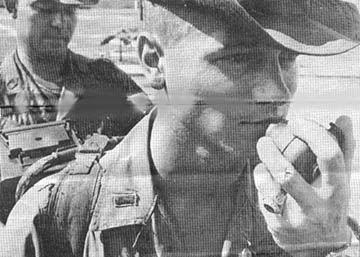 |
TESTING: ONE, TWO - First Lieutenant Curt Pradelt of Chicago, Ill., 2d Brigade psychological operations officer, checks out the prototype man-carried speaker system which he developed for combat civic actions in Vietnam. Sergeant First Class Antonio Ruelas of Fayetteville, N.C., S-5 NCOIC, makes final adjustments. |
| MAKING CONNECTION - Staff Sergeant Gary Stinson of Lawton, Okla., wire section chief with the 2d Brigade signal section, connects two of the three PRC-77 antennas recently devised for battalion command and control ships. Chief Warrant Officer Dennis Wynn of Palacion, Tex., Menehune pilot, waits for the all-clear. | 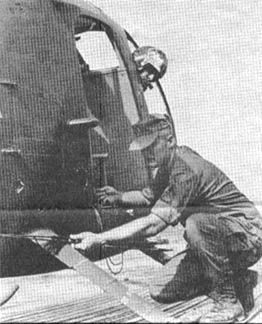 |
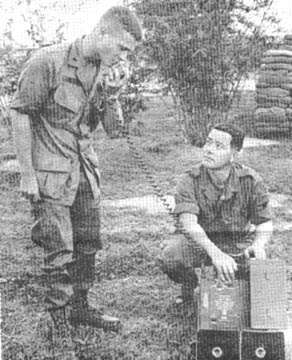 |
FIRST OF ITS KIND? - This portable speaker unit developed by First Lieutenant Curt Pradelt of Chicago, Ill., and Sergeant First Class Antonio Ruelas of Fayetteville, N.C., with the support of the 2d Brigade Signal and Civic Action staffs, has a range of better than 500 meters and is the first to be entirely contained in a single unit. Ruelas assists with the brigade's psychological operations missions. |
| ROCKET SYSTEMS installed on the Light Observation Helicopter (LOH) Cayuse such as the one on the right, are deadly accurate and demoralizing to the enemy. The system's addition to Tropic Lightning combat effectiveness is one of the recent successes of Warrior aviation. | 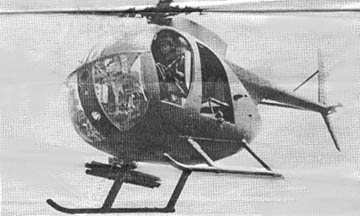 |
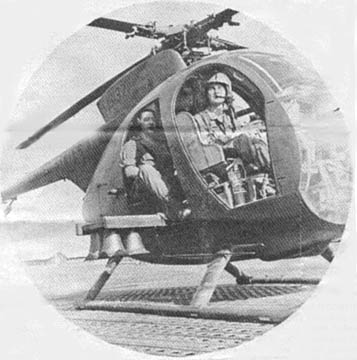 |
AIRBORNE SPEAKER - Light Observation Helicopters such as the one circled to the left, have aided the Chieu Hoi program and helped disseminate information. This system was developed for the Cayuse helicopter by 2d Bridate psychological operations personnel. Sergeant First Class Antonio Ruelas of Fayettville, N.C. takes the speaker as pilot Chief Warrant Officer Dennis Wynn of Palacion, Tex, prepares to crank her up. |
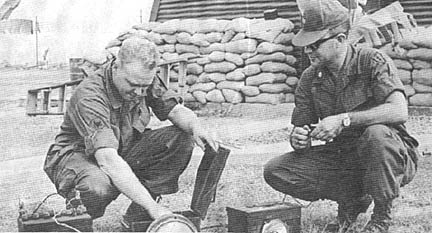 |
| THE COVER OF DARKNESS is easily withheld from the enemy by the use of this night lighting device developed by the 2d Brigade communications section. Major Paul Sposito of Crozet, Va., signal officer, holds the switch to the earlier model at right, while Specialist 4 Douglas Baird of North Claradon, Vt., connects the unit currently being tested. |
|
Story And Photos By 1Lt J. N. Black |
Page 6 TROPIC LIGHTNING NEWS January 20, 1969
Triple
Deuce Company Hit, Ambush Turned On Enemy
DAU
TIENG
- Four enemy soldiers died after they attacked an armored personnel carrier of
Alpha Company, 2d Battalion (Mechanized), 22d Infantry.
The command track of First
Lieutenant James O'Leary of Boston, Mass., a platoon leader, had established
an outpost along Route 14 three miles south of Dau Tieng, 42 miles northwest of
Saigon.
"An RPG-7 rocket grenade
was fired at us out of a woodline across the road," said O'Leary. It missed, landing in trees behind the outpost position, but
sending fragments which hit the track.
O'Leary's men answered
with machinegun and small arms fire as the rest of the platoon's armored
personnel carriers came rushing up from positions along the road.
Specialist 4 Robert
Arrington of Vidalia, La., spotted two enemy running away from the woodline as
the Triple Deuce tracks of the 3d Brigade formed on line.
"He almost tripped into
it," said Staff Sergeant Bruce Hay of Anamosa, Iowa, the platoon sergeant.
As Morgan stepped back, an enemy soldier popped up and began firing.
The mechanized infantrymen threw in grenades which silenced the spider
hole and a bunker complex beneath it.
A search of the bunker found
the four dead enemy as well as four RPG rocket grenade launchers, two RPG-7
rounds and half a dozen smaller RPG-2 rounds, four AK-47 assault rifles and
various items of North Vietnamese Army web gear.
"They had quite a few
weapons down there, so they must have planned a bigger attack," commented Hay.
"Our tracks pulled up so fast that they didn't have a chance to get
organized."
PX
Goes Into Field
By 1Lt Mack
Gooding
TAY
NINH
- Many modern conveniences of base camp living are now available to the 1st
Brigade field troops thanks to a program that brings choice post exchange items
out to the jungles and rice paddies throughout the Tay Ninh area.
"Almost every day we sent
out a convoy full of those things the infantryman wants most," said First
Lieutenant William H. Wilson of Seattle, Wash., the 1st Brigade
exchange officer.
"Each battalion that we
service here at the Tay Ninh base camp sends one or two trucks over to our
warehouse to pick up a loaded conex. Then
each miniature PX is taken out to a fire support base or a forward location for
distribution to the eager troops," continued Wilson.
"We send an ample supply of candy; canned food, crackers and other
snacks as well as plenty of pens, books and magazines," said Specialist 4 Jose
Rodriguez of New York City, the man in charge of supplying each conex with
merchandise.
"The men sure go for those
goodies," said Captain Ronald C. Owens of Baltimore, adjutant for the 3d
Battalion, 22d Infantry. "Every
time a conex has been delivered to Fire Support Base Buell the men could hardly
wait to grab up the items, pay the cashier and run off to enjoy their
purchases."
| RED CROSS WORKER Lou Jones talks to an ARVN soldier after distributing gifts at Fire Support Base Meade. The gifts, donated by the people of Indiana through the Hoosier Airlift Committee, were distributed Christmas Eve and Day by a volunteer group of soldiers and Red Cross Girls. (PHOTO BY SP4 LARRY WEIST) | 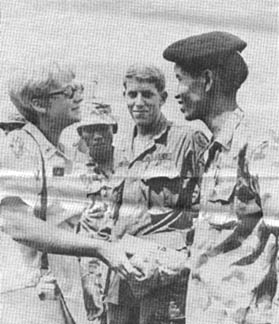 |
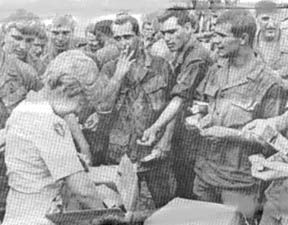 |
CHRISTMAS GIFTS donated by the people of Indiana are distributed on Christmas Day to troops at Fire Support Bose Keene by Red Cross Worker Linda Lou Jones of Shelbyville, Ind. (PHOTO BY SP4 LARRY WEIST) |
'Hoosier
Airlift' Brightens Yuletide
CU
CHI -
Christmas was made a bit merrier for many of the division's troops in the
field this year thanks. to presents from a group of citizens of Indiana.
In cooperation with the Haag
Drug Company, Indianans organized "Hoosier Airlift to Vietnam" to provide
thousands of Christmas gifts for 20 military organizations selected to be
recipients.
The individual packages
contained such necessities as razor kits, shampoo, foot powder, pens,
flashlights, stationery and reading material.
In a letter to Major General
Ellis W. Williamson, division commanding general, Colonel J.R. Burkhart, the
military advisor to the Hoosier Airlift Committee, said, "the gifts were a
means of expressing the appreciation of the citizens of Indiana for the
sacrifices made by all the fighting men in Vietnam."
The gifts were distributed
to the men by a volunteer group of soldiers and Red Cross girls as they toured
field locations on Christmas Eve and Christmas Day singing carols.
Tomahawk
Attack Kills Ten Viet Cong
TAY
NINH
- While on a sweep seven miles northeast of Tay Ninh City, Company A, 4th
Battalion, (Mechanized), 23d Infantry, was greeted by an estimated platoon of
Viet Cong.
The VC opened up on the
Tomahawks with small arms and RPG fire, but their advantage of surprise was
short-lived. Within seconds the
Tomahawks were returning fire on the hidden foe.
"The men were magnificent.
They fought with everything they had.
The tide of the fire fight was going our way the whole time," said
Sergeant James Gerrity, of Chicago.
The contact lasted for five
hours and during that time an awesome array of fire power was directed at the
enemy. The 7th Battalion, 11th
Artillery, fired 1,350 rounds of 105mm and 155mm shells into the immediate Viet
Cong area. Cobra gunships were on
station throughout the battle delivering their lethal punch whenever needed.
Once again the Air Force showed their strength and accuracy in making
exact air strikes.
When contact was finally
broken and the smoke lifted from the battle scene, the Tomahawks moved forward
to survey the damage. The final
count was ten VC killed by the Tomahawks and eight VC killed by air strikes and
artillery.
The Tomahawks commander,
Lieutenant Colonel Albert C. Butler, of Jackson, Miss., was very pleased with
the way his men handled the situation. "The
men have passed the supreme test. They
performed in the most professional way."
Page 7 TROPIC LIGHTNING NEWS January 20, 1969
Dustoff
Teamwork Provides Quick, Lifesaving Medevacs
CU
CHI -
1:13 p.m: A call is received in the
radio shack of the 159th Medical Detachment. A field unit needs a medical
evacuation helicopter - a dust-off chopper.
1:14 p.m: The chopper lifts off the pad at the 159th on its way to the
coordinates given during radio contact.
1:21 p.m: The dustoff identifies the smoke popped and sets down in a
clearing that moments before had been the scene of a fierce firefight.
1:23 p.m: The chopper lifts off with eight patients aboard.
1:30 p.m: The dustoff shuts down at the 25th Medical Battalion back at
the 25th Infantry Division's Cu Chi base camp.
Within 20 minutes from the time the unit in the field radioed
for its dustoff, the wounded were receiving professional medical treatment in
hospital conditions.
The efficiency of the 159th
Medical Detachment's team does not come easily.
There is always a crew on 'First Up' status ready to move out at a
moment's notice. And that crew
(aircraft commander, pilot, medic and crew chief) is always a highly trained
team of professionals.
When the field unit calls
the 159th's radio shack, coordinates are given along with the frequency and
call sign of the ground unit. The
crew is informed about the security of the area and how the area will be marked.
Hopefully, information concerning the number of wounded and type of
injuries will be available. But the dustoff crew must be prepared for anything.
During the dustoff, teamwork
is the keyword. The crew chief,
whose job is to make sure the helicopter is in top shape, often becomes an
assistant medic when patients are loaded onto the chopper.
Sometimes split-second adjustments must be made to accommodate more than
the four stretcher and four ambulatory patients the chopper is equipped to
carry.
Usually no more than two or
three minutes are spent loading the wounded onto the chopper.
Then the dustoff must lift its heavy load quickly.
Because the load is heavy and the mission is vital, the dustoff chopper
has more horsepower than a gunship slick.
During the flight to the
25th Medical Battalion, the medic usually has his hands full treating the
wounded. Again, the crew chief acts
in the capacity of an assistant medical man.
When the chopper shuts off at the 25th Med., the wounded are immediately
given medical treatment.
The crew then
returns to wait at the l59th - wait for the next radio call that could come
anytime.
|
Story, Photos By SP5 Joe Moore |
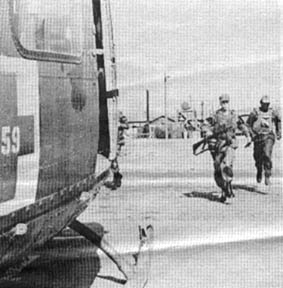 |
EVERY SECOND COUNTS - A field unit has called for a dustoff. The men of the 159th Medical Detachment waste no time in getting their chopper up. |
| HEAVY LOAD LIFTED - Before those who helped load the dustoff choppers can move out of the area, Tropic Lightning's wounded are on their way to the 25th Medical Battalion. | 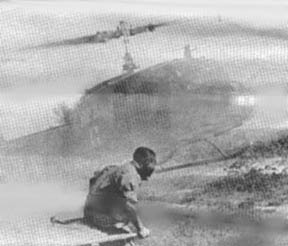 |
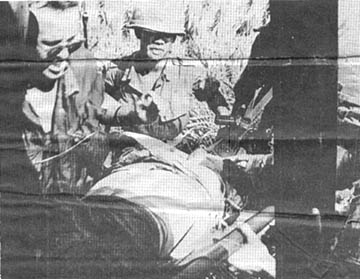 |
| EVERYONE HELPS - When the choppers set down, wounded are loaded quickly. |
Triple
Deuce Institutes New Type 'Buddy System'
DAU TIENG - Ten seasoned
veterans who have been in Vietnam for many years, who speak the language
fluently and who even know a few of the villagers have joined a company of the
3d Brigade.
In an effort to strengthen
coordination of American and Vietnamese forces against the enemy, Lieutenant
Colonel Ralph M. Cline of Rockville, Md., commander of the 2d Battalion (Mech),
22d Infantry, has instituted what he terms a buddy system.
The new program has brought
members of the Army of the Republic of Vietnam (ARVN) into a platoon of the
Triple Deuce Charlie Company.
"It is my belief that
occasional misunderstanding between American and South Vietnamese soldiers has
been caused by a lack of familiarization with each other's tactics and
customs," said Cline.
Thus far both the ARVNs and
American soldiers have been highly satisfied with the results of the move.
"Of course our biggest
problem is communication," said First Lieutenant Frederick Young of Hopswell,
Ohio, platoon leader of the 1st platoon. "We
have to use Pidgin English - half Vietnamese and half English.
And we have to use hand movements."
But the enthusiastic ARVNs
have learned quickly and are able to tell their American cohorts what they are
thinking. "So far we've only
had to show them our methods once and then they do it right from then on.
It's amazing," noted Young.
At first the Vietnamese
infantrymen were somewhat baffled by being asked to carry ammo for the M-40
machinegun, according to Sergeant Jerry Birmingham of Sulligent, Ala., a squad
leader.
"They are accustomed to
the .30 caliber machinegun and aren't used to having plenty of ammunition the
way G.I.s expect," he explained. When
they understood the abundance of ammunition the new members of the platoon began
wearing belts of M-60 ammo with pride, he added.
As the program now stands
the ARVNs, members of Popular and Regional Forces from military districts near
Dau Tieng, 45 miles northwest of Saigon, are assigned to the platoon for one
week.
The ARVNs have all
volunteered for the program and are given an opportunity to look it over before
deciding whether they would like to remain with the company.
Cline is attempting to extend the program to two or three weeks for each
man when possible.
So far the American Triple
Deuce mechanized infantrymen have nothing but praise for their Vietnamese
buddies. "One of the biggest
benefits of this program that I have noticed is that the people treat us
differently," said Young.
"Before, when we came
through a village, some of them wouldn't have much to do with us.
Now, with the ARVNs as members of each individual squad, they notice us
and are more friendly."
He said that the ARVNs talk
to villagers and explain what the Triple Deuce armored personnel carriers and
infantrymen are at tempting to do.
"It creates a feeling of
kinship that we have never before been able to attain," said Young.
Dragon
Security Man Stumbles Upon Cache
CU
CHI -
Acting as a security element for a work party outside the wire at Fire Support
Base Keene was rewarding for one 1st Brigade trooper of the 2d Battalion, 14th
Infantry.
Private First Class James
Raver of Columbus, Ohio, of Bravo Company was checking a hedgerow when he
discovered what appeared to be a caved-in tunnel.
"I noticed a piece of web gear sticking out of the hole, and when I
uncovered it I found a VC pack with an RPG-7 attached," stated the surprised
soldier.
Captain John Mader,
commanding officer of Echo Company, was summoned and had an RTO call in for
shovels.
"Before the shovels
arrived, several other men joined Raver and were digging with their hands,"
said Mader of Cleveland, Ohio.
The cache included 6 AK-47s,
1000 rounds of AK ammo, and other ammunition and explosives.
Page 8 TROPIC LIGHTNING NEWS January 20, 1969
The
Reverend Billy Graham Visits Three Lightning FSB's
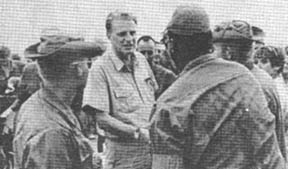 CU
CHI -
The Reverend Billy Graham concluded his handshaking tour of Vietnam with visits
to three 25th Infantry Division fire support bases on Christmas Day.
CU
CHI -
The Reverend Billy Graham concluded his handshaking tour of Vietnam with visits
to three 25th Infantry Division fire support bases on Christmas Day.
Dr. Graham was escorted
while at the Tropic Lightning Division by Division Chaplain (Lieutenant Colonel)
Duncan Stewart of Schenectady, N.Y.
Dr. Graham and Chaplain
Stewart were classmates at Wheaton College in Wheaton, Ill.
Dr. Graham was graduated in the class of '43, and Chaplain Stewart,
whose education was interrupted by military service, graduated in the Class of
'47.
The men at Fire Support Base
Rawlins, Wood and Pershing heard words of encouragement from Dr. Graham.
GRAHAM
TOURS THE DIVISION
- (Above, right) The Reverend Billy Graham (center) leaves his chopper talk with Division
troops during his visits to fire support bases on Christmas Day.
(PHOTO
BY SP4 LARRY WEIST)
| DO NOT ENTER—Specialist 4 Dan Watkins, a Tropic Lightning soldier from C Company, 2d Battalion, 14th Infantry points out one of the many boobytrap warning signs found during a recent sweep near Duc Hoa. The 2d Brigade soldier is from DeWitt, Ark. (PHOTO BY SP4 E. R. JAMES) | 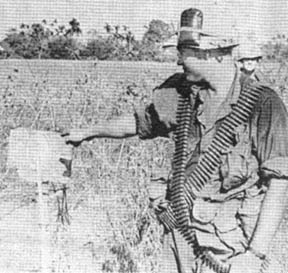 |
Helmet
Stops Bullet
TAY
NINH
- "When I felt the bullet hit my helmet, I thought it was all over,"
commented Private First Class Eugene Thompson of Buford, Ga.
It's because he wears his
steel helmet religiously that he is alive today.
Without it a round from an AK-47 rifle
would have hit him in the head.
Thompson, a machinegunner,
assigned to the 4th Battalion (Mechanized), 23d Infantry, found himself in an
unusual predicament recently. While
in the midst of a savage fire fight near Tay Ninh City, Thompson's M-60
machinegun was hit by small arms fire.
One enemy round smashed into
the front of his machinegun, whizzed down the length of the weapon until it hit
the feed tray. After ricocheting
off the feed tray, the bullet flew into his steel helmet. The round spun around numerous times before falling to the
ground.
"That was a close shave
Viet Cong style," said the 1st Brigade trooper after the ordeal.
Mobility
Idea No Joke To Arty
In 6 Hours - Grant To Mitchell
CU
CHI
- "On time, on target" is the motto of the 7th Battalion, 11th
Artillery. Just recently C Battery
showed why this motto is so appropriate and displayed how its men live up to it.
C Battery was given the
order to move out of Fire Support Base Grant ten miles northeast of Tay Ninh.
Two hours later the entire firing battery had left Fire Support Base
Grant enroute to their new position, Fire Support Base Mitchell four miles
southwest of Tay Ninh.
The battery moved out by
convoy and arrived at Mitchell. The
entire move took only four hours. Fifty minutes after arrival at Mitchell, all
six 105mm howitzer guns were laid and ready to fire.
The artillery's ability to react in such a short time is in keeping
with the modern concept of artillery combat operations. These sudden changes upset the enemy's plans and lessen the
chances of a concentrated attack.
Just two days prior to their
movement from Grant to Mitchell, C Battery had made a move from Fire Support
Base Bragg to Grant. After working
two straight days building up Grant, they were ordered to move.
Upon arrival at Mitchell,
they found nothing there but three bulldozers clearing away the jungle.
Thus, C Battery had to start completely from scratch in building the new
fire support base.
Before leaving Fire Support
Base Grant, they first had to completely destroy it. They emptied every sand bag and took the empty sand bags.
C Battery left Grant the
same way they found Mitchell - barren. To
help beef up the defenses at Fire Support Base Mitchell, filled sand bags were
removed from the Holiday Inn stand-down complex at Tay Ninh base camp.
New sand bags have since been replaced at the Holiday Inn.
In addition to the day's
movement and the great task of building the new fire support base, C Battery
fired 600 105mm howitzer rounds during the first night there.
The entire battery was up all night working and manning the guns.
According to the 7th
Battalion, 11th Artillery assistant S-3 Captain Louis Salz of Newark, NJ., "It
was an excellent move with all sections being well coordinated.
It was accomplished in a minimum amount of time, and all the men
performed their duties expertly."
Captain James F. Harvey, the
battery commander from Annandale, Va., said:
"The movement was important as a tactical operation since it blocks
enemy advancement on Tay Ninh. The
move was planned and developed in a single day to meet a sudden threat.
The artillery was required to perform with a great deal of flexibility,
since the exact location of the new site was unknown until after the move was
initiated."
BG
Black Arrives...
(Continued
From Page 1)
J-5 Division, CINCPAC. In August,
1958, he returned to the United States and was assigned to the Executive Office
of the President for duty with the staff of the Operations Coordinating Board,
Washington, D.C.
In June, 1959 he moved to
the Office of the Secretary of Defense as Military Assistant to the Deputy
Secretary of Defense. He served
under three Deputy Secretaries of Defense:
Mr. Gates, Mr. Douglas and Mr. Gilpatric.
I June, 1961, he was selected to attend the National War College,
Washington, D.C.
In July, 1963, he joined the
Plans Division, CINCPAC. During
this tour of duty he was specially selected to serve as a member of a Tactical
Air Sup0port Procedures Board appointed by the Commander in Chief, Pacific.
In December, 1964 he returned to Vietnam and was assigned to the J-3
Division U.S. Military Assistance Command.
In August, 1965, General Black returned to the United States and was
appointed Director, Western Hemisphere Region, Office of the Secretary of
Defense, Washington, D.C.
He assumed command of
Headquarters, U.S. Army Support, Thailand on 11 December, 1966 at camp
Friendship, Korat, Thailand. He has been awarded the Bronze Star Medal, the
Joint Service Commendation Medal with
one Oak Leaf Cluster and the Senior Parachutist's Badge.
General Black is married to
Margaret Cobey of Washington, D.C. and has six children. His home is in Honolulu, Hawaii.
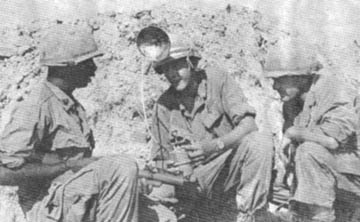 |
CHARLIE'S FLASHLIGHT - This gas-operated lantern was found along with a weapons cache by C Company, 3d Battalion, 22d Infantry, seven miles northwest of Tay Ninh. Private First Class Ralph A. Wilks of Niles, Mich., shows his find to Specialist 4 Raymond Givens of Leesburg, Fla., and Steve Grippi of Ashtabula, Ohio. (PHOTO BY SP4 DAVID DE MAURO) |
Thanks to
Mack D. Gooding, 15th PID, 1st Bde., for sharing this issue,
Kirk Ramsey, 2nd Bn., 14th Inf. for creating this page.
This page last modified 8-12-2004
©2004 25th Infantry Division Association. All rights reserved.